

|
Rocky Mountain
National Park - Complete Information Resource
Wildlife:
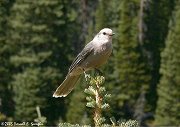 Although
Rocky Mountain National Park is most famous for its large animals,
particularly elk and bighorn sheep, a glimpse of a
tufted-eared Abert's squirrel, an iridescent
broad-tailed hummingbird, or a squeaking pika can be
equally thrilling. Early risers, and those watching at
dusk often have the best "luck" at seeing
wildlife. Although
Rocky Mountain National Park is most famous for its large animals,
particularly elk and bighorn sheep, a glimpse of a
tufted-eared Abert's squirrel, an iridescent
broad-tailed hummingbird, or a squeaking pika can be
equally thrilling. Early risers, and those watching at
dusk often have the best "luck" at seeing
wildlife.
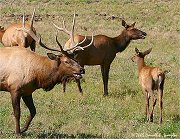 Elk,
mule deer, moose, bighorn sheep, black bears, coyotes,
cougars, eagles, hawks and scores of smaller animals
delight wildlife-watchers of all ages. Wildflower-lovers
are never disappointed in June and July when the meadows
and hillsides are splashed with botanical color. Autumn
visitors can relax among the golden aspens or enjoy the
rowdier antics of the elk rut (mating season). Elk,
mule deer, moose, bighorn sheep, black bears, coyotes,
cougars, eagles, hawks and scores of smaller animals
delight wildlife-watchers of all ages. Wildflower-lovers
are never disappointed in June and July when the meadows
and hillsides are splashed with botanical color. Autumn
visitors can relax among the golden aspens or enjoy the
rowdier antics of the elk rut (mating season).
|
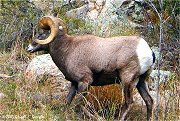 Rocky
Mountain National Park visitors have a passion for
viewing wild animals, especially the big ones. With
an elk herd numbering more than 3,000, about 800
bighorn sheep, numerous mule deer and a small
population of moose calling the park home, it's no
surprise that wildlife watching is rated the
number-one activity by a vast majority of Rocky's
three million annual visitors. Rocky
Mountain National Park visitors have a passion for
viewing wild animals, especially the big ones. With
an elk herd numbering more than 3,000, about 800
bighorn sheep, numerous mule deer and a small
population of moose calling the park home, it's no
surprise that wildlife watching is rated the
number-one activity by a vast majority of Rocky's
three million annual visitors.
|
|
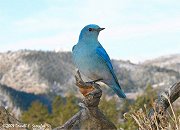 The
park's great large-animal population makes it one of
the country's top wildlife watching destinations.
But there is much more to see than these so-called
"charismatic megafauna." Also found are
nearly 60 other species of mammals; more than 280
recorded bird species; six amphibians, including the
federally endangered boreal toad; one reptile (the
harmless garter snake); 11 species of fish; and
countless insects, including a surprisingly large
number of butterflies. The
park's great large-animal population makes it one of
the country's top wildlife watching destinations.
But there is much more to see than these so-called
"charismatic megafauna." Also found are
nearly 60 other species of mammals; more than 280
recorded bird species; six amphibians, including the
federally endangered boreal toad; one reptile (the
harmless garter snake); 11 species of fish; and
countless insects, including a surprisingly large
number of butterflies.
|
|
Some basic knowledge of animal habits and habitats
greatly enhances prospects of spotting Rocky
Mountain's wild residents. A few park favorites:
-
Elk
can be seen anytime, a popular viewing period
being the fall rut, or mating season. Look for
elk in meadows and where meadow and forest meet.
Elk spend much of their time at or above
treeline during the summer, moving to lower
elevations in the fall, winter and spring.
Favorite feeding times: dawn and dusk.
-
Bighorn
sheep are commonly seen at Sheep Lakes from
May through mid-August.
-
Moose
frequent willow thickets along the Colorado
River in the Kawuneeche Valley on the park's
west side.
-
Otters
were reintroduced into the Colorado River area
and are doing fairly well. These animals are
difficult to spot.
-
Mule
deer are common and can be seen anywhere. They
are most often found at lower elevations in
open areas.
-
Bats
feed over lakes and ponds at dawn and dusk.
-
Marmots
and pikas favor rocky areas. Marmots are best
seen on the alpine tundra along Trail Ridge
and Old Fall River roads. Pikas - small,
light-colored mammals - are common in rock
piles. Listen for their sharp, distinctive
bark and watch for movement.
-
Clark's
nutcrackers, Steller's jays, golden eagles and
prairie falcons can be seen along Trail Ridge
Road.
-
White-tailed
ptarmigans, some of the most sought-after
birds in Rocky Mountain National Park, are
common but difficult to spot. For best
results, hike on the tundra and look
carefully. Ptarmigans usually remain still,
relying on their natural camouflage for
protection.
-
American
dippers, or water ouzels, can be found along
most streams. Listen for their loud call,
similar to the rapid clicking of two stones
together, as they fly up and down their
territories.
Tips For Successful, Enjoyable
Wildlife Watching
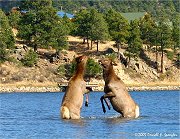 Despite
their good intentions, some wildlife watchers are
loving park animals to death. Feeding junk food to
wildlife reduces its ability to survive the long
mountain winter. When they panhandle by roadsides,
animals fall easy prey to automobiles. As they
become habituated to humans and lose their natural
fear, the animals become aggressive and may be
destroyed. Harassing or feeding wildlife is illegal
in all national parks. Despite
their good intentions, some wildlife watchers are
loving park animals to death. Feeding junk food to
wildlife reduces its ability to survive the long
mountain winter. When they panhandle by roadsides,
animals fall easy prey to automobiles. As they
become habituated to humans and lose their natural
fear, the animals become aggressive and may be
destroyed. Harassing or feeding wildlife is illegal
in all national parks.
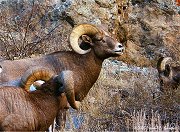 Watch from a distance. Use binoculars or a telephoto
lens to get close-up views. Following larger animals
too closely to get a photograph or a better look can
stress them and threaten their health. If animals
notice you or if they seem nervous, you are too
close. Move away quietly.
Watch from a distance. Use binoculars or a telephoto
lens to get close-up views. Following larger animals
too closely to get a photograph or a better look can
stress them and threaten their health. If animals
notice you or if they seem nervous, you are too
close. Move away quietly.
-
Obey
all signs posting closed areas. At different
times of the year, some park areas are closed to
protect wildlife during nesting, mating and
birthing seasons.
-
Keep
pets in your vehicle. Pets may scare wildlife,
and wild animals can hurt the pet.
-
Use
of wildlife calls and spotlights is illegal.
They stress animals and alter their natural
behavior.
-
Some
large animals such as elk, sheep, bears and
mountain lions are dangerous. Check at visitor
centers for tips on safety around wildlife.
-
Drive
slowly. Watch for animals crossing the road.
Deer and elk are seldom alone. If you see one
animal, look for others that may follow.
-
Stop
your car to watch animals only if you can pull
off the road safely. Do not block traffic.
-
When
possible, get away from roadsides and sit
quietly to observe and listen for wildlife.
Talk only when necessary, and do so quietly so
you don't disturb the animals or other
wildlife watchers. If viewing wild animals
from your vehicle, turn off the motor.
|
Bookmark This Page
|

|